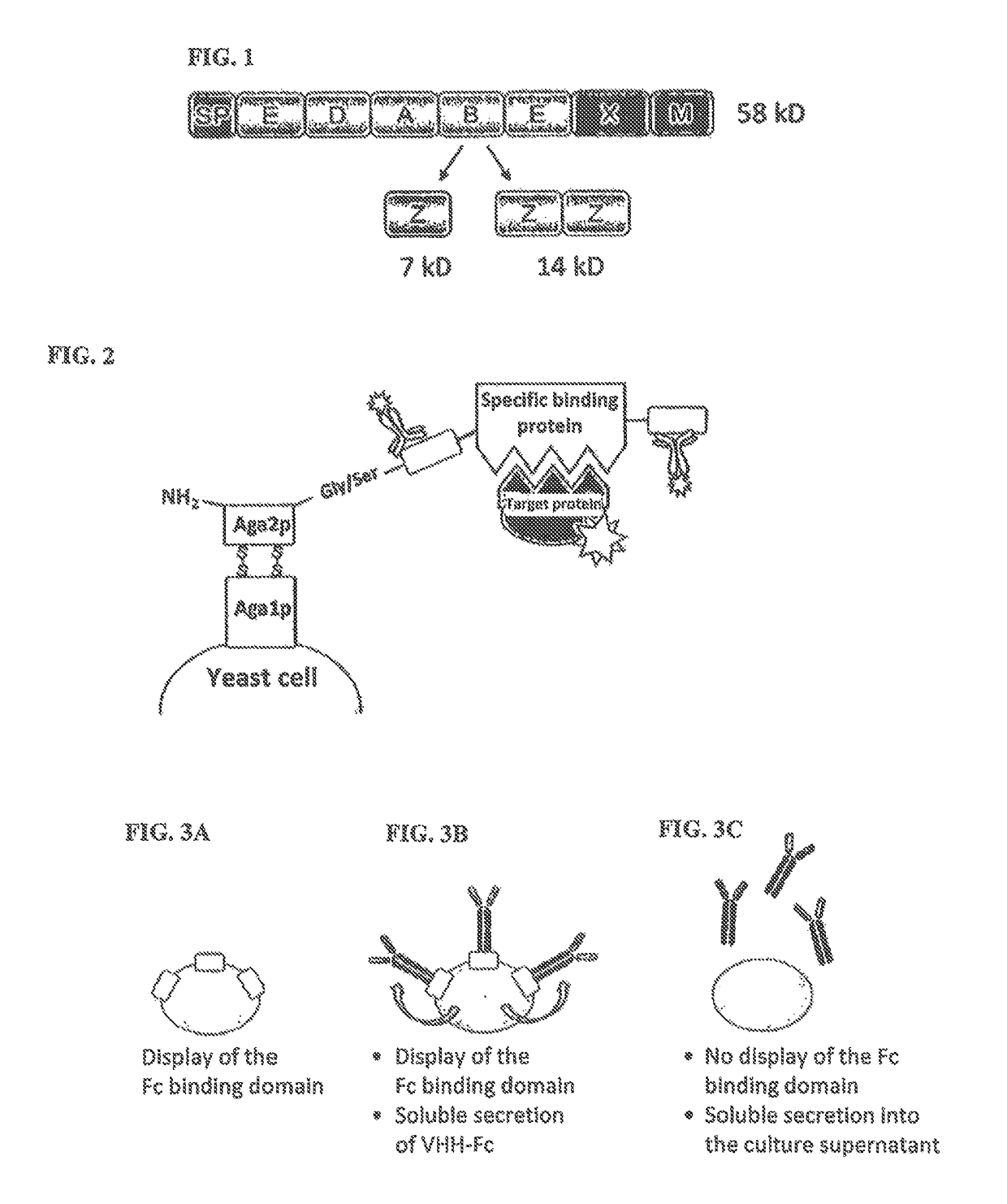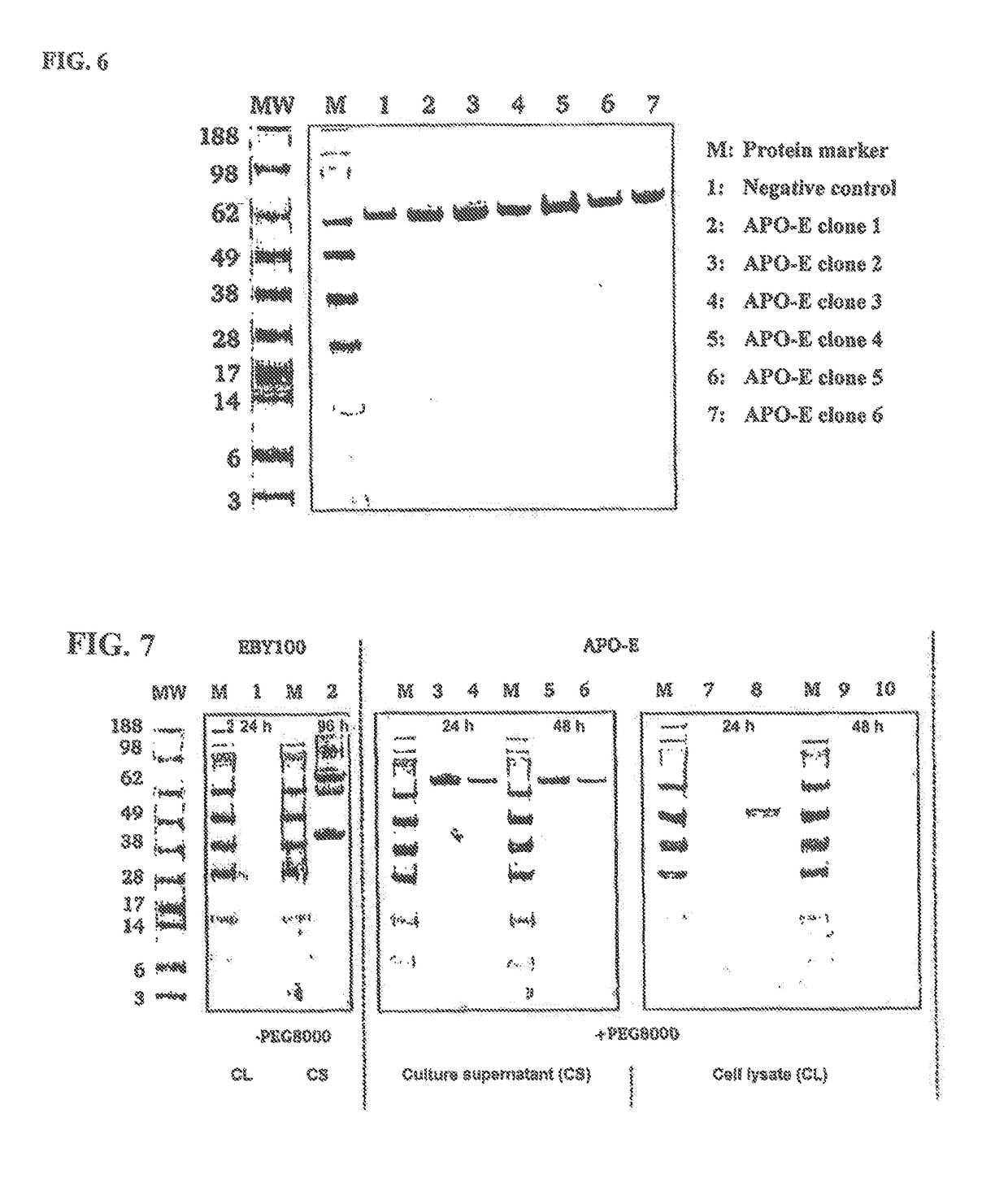Method of producing secretable antibodies by expression in saccharomyces cerevisiae
a saccharomyces cerevisiae and expression method technology, applied in the field of monoclonal antibodies, can solve the problems of limiting the use of phage display methods, affecting the specificity and affinity of antibodies, and posttranslational modifications, such as e.g. glycosylation, which can influence the specificity and affinity of antibodies, and achieves the effect of accelerating and simplifying
- Summary
- Abstract
- Description
- Claims
- Application Information
AI Technical Summary
Benefits of technology
Problems solved by technology
Method used
Image
Examples
example 1
on of a Method for Non-Covalent Surface Display on Yeast Cells and Soluble Production
[0139]The aim of the present work was the development of a method for non-covalent surface display of IgG molecules and Fc fusion proteins on yeast cells, the associated selection and the subsequent switchable secretion of the selected protein into the medium of an expression culture for biochemical characterisation thereof. The method for non-covalent surface display on yeast cells was realised by the interaction of the Fc binding domain derived from protein A and covalently anchored on the cell surface and the co-expression of a VHH-Fc fusion protein or an IgG molecule. The soluble secretion of the VHH-Fc fusion proteins into the culture supernatant was achieved by modification of the expression conditions. As a result time-consuming reformatting steps of the expression plasmid which are necessary for soluble production of the selected clone e.g. in comparable selection methods, such as surface di...
example 2
n of a Yeast Strain which Overexpresses PDI
[0140]The oxidoreductase PDI (protein disulphide isomerase) is an ER-located enzyme which catalyses the oxidation and reduction of disulphide bridges in substrate proteins137. It has been demonstrated in an already published study that overexpression of this enzyme leads to an increased secretion of scFv fragments from the yeast118. Rakestraw and colleagues showed in 2009 that the overexpression of PDI led to a significant increase in the amount of IgG secreted from yeast cells and that the integration of a PDI expression cassette into the yeast genome is preferable to an episomal expression of the PDI for increasing the secretion of heterologous proteins111. The results of the generation of the S. cerevisiae strain APO-E are presented in the following. It was presumed in advance that PDI overexpression increases the secretion output of the yeast strain for VHH-Fc fusion proteins. This yeast strain was generated by chromosomal integration o...
example 3
of VHH-Fc Fusion Proteins
[0141]In this section the results of the soluble secretion of VHH-Fc fusion proteins from yeast cells are presented in order to check the secretion output of the S. cerevisiae strains EBY100 and APO-E for VHH-Fc fusion proteins. Since VHH is a single-chain domain, the complexity of the experimental set-up was therefore reduced compared with the use of whole, multichain IgG molecules. In addition to the secretion output of the individual strains, the influence of the gene dose on the secreted amount of protein was also investigated. For this purpose expression plasmids which had different replication origins (oris) and were generated beforehand via homologous recombination in yeast cells were used. For this purpose the DNA sequence of the VHH-Fc construct was amplified with specific oligodeoxyribonucleotides from the plasmid pYD-pGal1-app8-VHH1-Fc and cloned into the linearised vector pESC-Leu. As a result the vector pESC-pGal1-app8-VHH1-Fc with the 2 micron ...
PUM
| Property | Measurement | Unit |
|---|---|---|
| pH | aaaaa | aaaaa |
| pH | aaaaa | aaaaa |
| thick | aaaaa | aaaaa |
Abstract
Description
Claims
Application Information
 Login to View More
Login to View More - R&D
- Intellectual Property
- Life Sciences
- Materials
- Tech Scout
- Unparalleled Data Quality
- Higher Quality Content
- 60% Fewer Hallucinations
Browse by: Latest US Patents, China's latest patents, Technical Efficacy Thesaurus, Application Domain, Technology Topic, Popular Technical Reports.
© 2025 PatSnap. All rights reserved.Legal|Privacy policy|Modern Slavery Act Transparency Statement|Sitemap|About US| Contact US: help@patsnap.com



